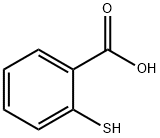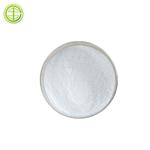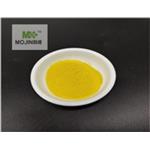Chemical Properties
Thiosalicylic acid, (o-mercapto benzoic acid), a sulfur-yellow solid that softens at 158 °C (316 °F), has a melting point of 164 °C (327 °F). It sublimes, is slightly soluble in hot water but freely soluble in glacial acetic acid and alcohol, and yields dithiosalicylic acid, upon exposure to air.
Uses
Thiosalicylic acid acts as a trapping agent, which is useful in the desulfenylation of 3-indolyl sulfides. It is used to prepare macrocyclic diamides by condensation with diamines. Further, it is used as a precursor to drug, which finds application for the treatment of atherosclerosis and melanoma. In addition to this, it is involved in the preparation of vaccine preservative thiomersal and thioindigo dyestuff.
Preparation
Thiosalicylic acid can be prepared from anthranilic acid via diazotization followed by the addition of sodium sulfide and then reduction with zinc. It can also prepared by heating o-halogenated benzoic acids with alkaline hydrosulfide in presence of copper.
Application
thiosalicylic acid can be used as:
A nucleophilic trapping agent for the desulfenylation of 3-indolyl sulfides to obtain 3-unsubstituted indoles.
A starting material to prepare 2′-mercaptoacetophenone, which is used in the synthesis of thioflavanone by reacting with lithium diisopropylamide and benzaldehyde.
A stabilizing agent in the synthesis of metal nanoparticles.
It can also be used to prepare 2-thioxanthone-thioacetic acid bimolecular system, which is used as a photoinitiator for free radical polymerization.
Definition
ChEBI: Thiosalicylic acid is a sulfanylbenzoic acid that is the 2-sulfanyl derivative of benzoic acid. It has a role as a non-narcotic analgesic and an antipyretic. It is a conjugate acid of a thiosalicylate(1-).
Purification Methods
Crystallise the thio acid from hot EtOH (4mL/g), after adding hot distilled water (8mL/g) and boiling with charcoal. The hot solution is filtered, cooled, the solid is collected and dried in vacuo (P2O5). Crystallise it from AcOH and sublime in vacuo.[Beilstein 10 IV 272.]





